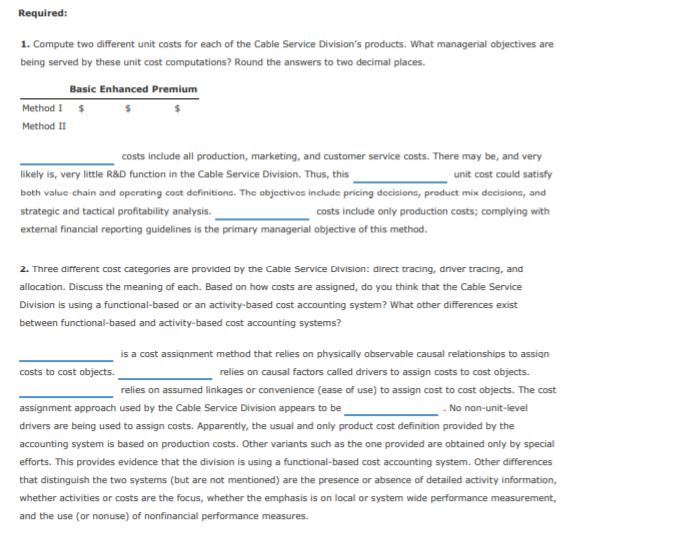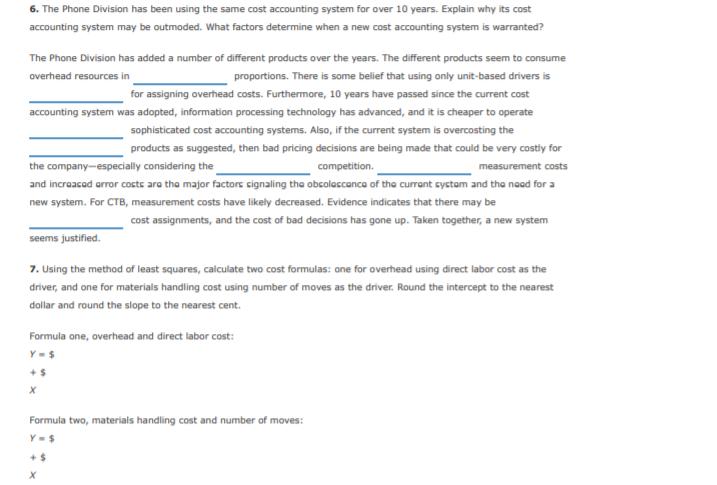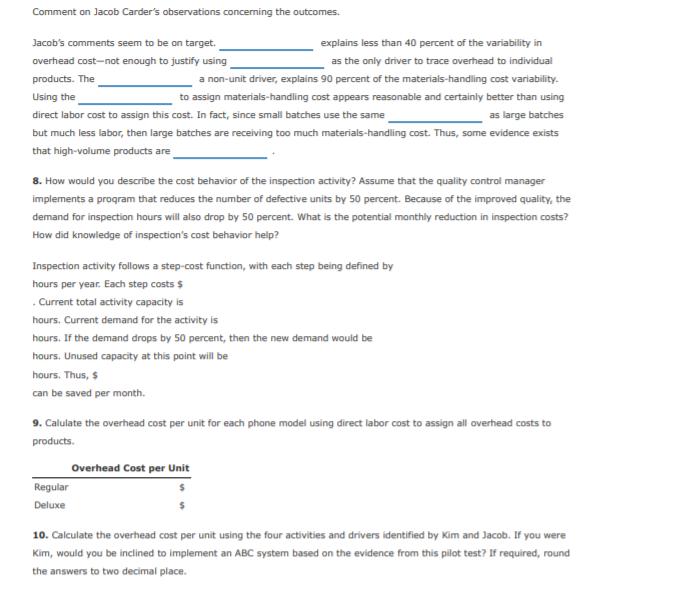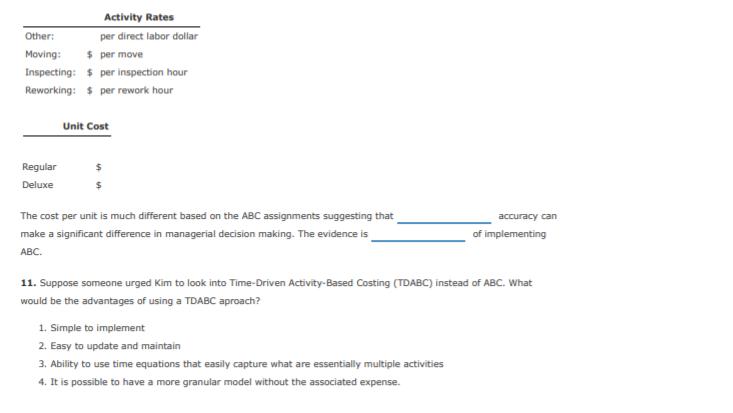Question
CableTech Bell Corporation (CTB) operates in the telecommunications industry. CTB has two divisions: the Phone Division and the Cable Service Division. The Phone Division manufactures
CableTech Bell Corporation (CTB) operates in the telecommunications industry. CTB has two divisions: the Phone Division and the Cable Service Division. The Phone Division manufactures telephones in several plants located in the Midwest. The product lines run from relatively inexpensive touch-tone wall and desk phones to expensive, high-quality cellular phones. CTB also operates a cable TV service in Ohio. The Cable Service Division offers three products: a basic package with 25 channels; an enhanced package, which is the basic package plus 15 additional channels and two movie channels; and a pre- mium package, which is the basic package plus 25 additional channels and three movie channels.
The Cable Service Division reported the following activity for the month of March:
Basic | Enhanced | Premium | |
Sales (units) | 50,000 | 500,000 | 300,000 |
Price per unit | $16 | $30 | $40 |
Unit costs: | |||
Directly traced | $ 3 | $ 5 | $ 7 |
Driver traced | $ 2 | $ 4 | $ 6 |
Allocated | $10 | $13 | $15 |
The unit costs are divided as follows: 70 percent production and 30 percent marketing and customer service. Direct labor cost is the only driver used for tracing. Typically, the division uses only production costs to define unit costs. The preceding unit product cost information was provided at the request of the marketing manager and was the result of a special study.
Bryce Youngers, the president of CTB, is reasonably satisfied with the performance of the Cable Service Division. March’s performance is fairly typical of what has been happening over the past two years. The Phone Division, however, is another matter. Its overall profit performance has been declin- ing. Two years ago, income before income taxes had been about 25 percent of sales. March’s dismal performance was also typical for what has been happening this year and is expected to continue— unless some action by management is taken to reverse the trend. During March, the Phone Division reported the following results:
Inventories:
Materials, March 1 | $ 23,000 |
Materials, March 31 | 40,000 |
Work in process, March 1 | 130,000 |
Work in process, March 31 | 45,000 |
Finished goods, March 1 | 480,000 |
Finished goods, March 31 | 375,000 |
Costs:
Direct labor | $117,000 |
Plant and equipment depreciation | 50,000 |
Materials handling | 85,000 |
Inspections | 60,000 |
Scheduling | 30,000 |
Power | 30,000 |
Plant supervision | 12,000 |
Manufacturing engineering | $ 21,000 |
Sales commissions | 120,000 |
Salary, sales supervisor | 10,000 |
Supplies | 17,000 |
Warranty work | 40,000 |
Rework | 30,000 |
During March, the Phone Division purchased materials totaling $312,000. There are no significant inventories of supplies (beginning or ending). Supplies are accounted for separately from materials. CTB’s Phone Division had sales totaling $1,170,000 for March.
Based on March’s results, Bryce decided to meet with three of the Phone Division’s managers: Kim Breashears, divisional manager; Jacob Carder, divisional controller; and Larry Hartley, sales manager. A transcript of their recorded conversation is given next:
Bryce: “March’s profit performance is down once again, and I think we need to see if we can identify the problem and correct it—before it’s too late. Kim, what’s your assessment of the situation?”
Kim: “Foreign competition is eating us alive. They are coming in with lower-priced phones of compa- rable or higher quality than our own. I’ve talked with several of the retailers that carry our lines, and they say the same. They are convinced that we can sell more if we lower our prices.”
Larry: “They’re right. If we could lower our prices by 10 to 15 percent, I think that we’d regain most of our lost market share. But we also need to make sure that the quality of our products meets that of our competi- tors. As you know, we are spending a lot of money each month on rework and warranties. That worries me. I’d like to see that warranty cost cut by 70 to 80 percent. If we could do that, then customers would be more satisfied with our products, and I bet that we would not only regain our market share but increase it.”
Jacob: “Lowering prices without lowering per-unit costs will not help us increase our profitability. I think we need to improve our cost accounting system. I am not confident that we really know how much each of our product lines is costing us. It may be that we are overpricing some of our units because we are overcosting them. We may be underpricing other units.”
Larry: “This sounds promising—especially if the overcosting is for some of our high-volume lines. A price decrease for these products would make the biggest difference—and if we knew they were over- costed, then we could offer immediate price reductions.”
Bryce: “Jacob, I need more explanation. We have been using the same cost accounting system for the last 10 years. Why would it be a problem?”
Jacob: “I think that our manufacturing environment has changed. Over the years, we have added a lot of different product lines. Some of these products make very different demands on our manufacturing overhead resources. We trace—or attempt to trace—overhead costs to the different products using direct labor cost, a unit-based cost driver. We may be doing more allocation than tracing. If so, then we probably don’t have a very good idea of our actual product costs. Also, as you know, with the way computer technology has changed over time, it is easier and cheaper to collect and use detailed infor- mation—information that will allow us to assign costs more accurately.”
Bryce: “This may be something we should explore. Jacob, what do you suggest?”
Jacob: “If we want more accurate product costs and if we really want to get in the cost reduction business, then we need to understand how costs behave. In particular, we need to understand activity cost behavior. Knowing what activities we perform, why we perform them, and how well we perform them will help us identify areas for improvement. We also need to know how the different products consume activity resour- ces. What this boils down to is the need to use an activity-based management system. But before we jump into this, we need some idea of whether non-unit-based drivers add anything. Activity-based management is not an inexpensive undertaking. So I suggest that we do a preliminary study to see if direct labor cost is adequate for tracing. If not, then maybe some non-unit-drivers might be needed. In fact, if you would like, I can gather some data that will provide some evidence on the usefulness of the activity-based approach.”
Bryce: “What do you think, Kim? It’s your division.”
Kim: “What Jacob has said sounds promising. I think he should pursue it and do so quickly. I also think that we need to look at improving our quality. It sounds like we have a problem there. If quality could be improved, then our costs will drop. I’ll talk to our quality people. Jacob, in the meantime, find out for us if moving to an activity-based system is the way to go. How much time do you need?”
Jacob: “I have already been gathering data. I could probably have a report within two weeks.”
TO: Kim Breashears
FROM: Jacob Carder
SUBJECT: Preliminary Analysis
MEMO
Based on my initial analysis, I am confident that an ABC system will offer significant improvement. For one of our conventional phone plants, I regressed total monthly overhead cost on monthly direct labor cost using the following 15 months of data:
Overhead | Direct Labor Cost |
$360,000 | $110,000 |
300,000 | 100,000 |
350,000 | 90,000 |
400,000 | 100,000 |
320,000 | 90,000 |
380,000 | 100,000 |
300,000 | 90,000 |
280,000 | 90,000 |
340,000 | 95,000 |
410,000 | 115,000 |
375,000 | 100,000 |
360,000 | 85,000 |
340,000 | 85,000 |
330,000 | 90,000 |
300,000 | 80,000 |
The results were revealing. Although direct labor cost appears to be a driver of overhead cost, it really doesn’t explain a lot of the variation. I then searched for other drivers—particularly non-unit drivers— that might offer more insight into overhead cost behavior. Every time a batch is produced, material movement occurs, regardless of the size of the batch. The number of moves seemed like a more logical driver. I was able to gather only 10 months of data for this. (Our information system doesn’t provide the number of moves, so I had to build the data set by interviewing production personnel.) This infor- mation is provided next:
Materials-Handling Cost | Number of Moves |
$80,000 | 1,500 |
60,000 | 1,000 |
70,000 | 1,250 |
72,000 | 1,300 |
65,000 | 1,100 |
85,000 | 1,700 |
67,000 | 1,200 |
73,500 | 1,350 |
83,000 | 1,400 |
84,000 | 1,700 |
The regression results were impressive. There is no question in my mind that the number of moves is a good driver of materials-handling costs. Using the number of moves to assign materials-handling costs to products would likely be better than the cost assignment using direct labor cost. Furthermore, since small batches use the same number of moves as large batches, we have some evidence that we may be overcosting our high-volume products.
I looked at one more overhead activity: inspecting products. We have 15 inspectors who are paid an average of $4,000 per month. Each inspector offers about 160 hours of inspection capacity per month. However, it appears that they actually work only about 80 percent of those hours. The drop in demand we have experienced explains this idle time. I see no evidence of variable cost behavior here. I’m not exactly sure how to treat inspection cost, but I think that it is more related to inspection hours than direct labor cost. Some of the other overhead activities seem to be non-unit-level, as well— enough, in fact, to be concerned about how we assign costs.
After receiving the memo, Kim was intrigued. She then asked Jacob to use the same phone plant as a pilot for a preliminary ABC analysis. She instructed him to assign all overhead costs to the plant’s two products (Regular and Deluxe models), using only four activities. The four activities were rework, moving materials, inspecting products, and a general catch-all activity labeled “other manufacturing activities.” From the special study already performed, she knew that materials handling and inspecting involved significant cost; from production reports, she also knew that the rework activity involved signif- icant cost. If the ABC and unit-based cost assignments did not differ by breaking out these three major activities, then ABC may not matter.
Pursuant to the request, Jacob produced the following cost and driver information:
Activity | Expected Cost | Driver | Activity Capacity |
Other activities | $2,000,000 | Direct labor dollars | $1,250,000 |
Moving materials | 900,000 | Number of moves | 18,000 |
Inspecting | 720,000 | Inspection hours | 24,000 |
Reworking | 380,000 | Rework hours | 3,800 |
Total overhead cost | $4,000,000 |
Expected activity demands:
Regular Model | Deluxe Model | |
Units completed | 100,000 | 40,000 |
Direct labor dollars | $875,000 | $375,000 |
Number of moves | 7,200 | 10,800 |
Inspection hours | 6,000 | 18,000 |
Rework hours | 1,900 | 1,900 |


![]()
![]()



Required: 1. Compute two different unit costs for each of the Cable Service Division's products. What managerial objectives are being served by these unit cost computations? Round the answers to two decimal places. Basic Enhanced Premium Method I $ Method II costs include all production, marketing, and customer service costs. There may be, and very likely is, very little R&D function in the Cable Service Division. Thus, this unit cost could satisfy both value chain and operating cost definitions. The objectives include pricing deciaions, product mix deciaions, and strategic and tactical profitability analysis. costs include only production costs; complying with external financial reporting guidelines is the primary managerial objective of this method. 2. Three different cost categories are provided by the Cable Service Division: direct tracing, driver tracing, and allocation. Discuss the meaning of each. Based on how costs are assigned, do you think that the Cable Service Division is using a functional-based or an activity-based cost accounting system? What other differences exist between functional-based and activity-based cost accounting systems? is a cost assignment method that relies on physically observable causal relationships to assign costs to cost objects. relies on causal factors called drivers to assign costs to cost objects. relies on assumed linkages or convenience (ease of use) to assign cost to cost objects. The cost assignment approach used by the Cable Service Division appears to be . No non-unit-level drivers are being used to assign costs. Apparently, the usual and only product cost definition provided by the accounting system is based on production costs. Other variants such as the one provided are obtained only by special efforts. This provides evidence that the division is using a functional-based cost accounting system. Other differences that distinguish the two systems (but are not mentioned) are the presence or absence of detailed activity information, whether activities or costs are the focus, whether the emphasis is on local or system wide performance measurement, and the use (or nonuse) of nonfinancial performance measures.
Step by Step Solution
3.42 Rating (168 Votes )
There are 3 Steps involved in it
Step: 1
Solution to Questions 111 Answer 1 Method I costs include all production marketing and customer service costs Basic Enhanced Premium Directly Traced 300 500 700 Driver traced 200 400 600 Allocated 100...
Get Instant Access to Expert-Tailored Solutions
See step-by-step solutions with expert insights and AI powered tools for academic success
Step: 2

Step: 3

Ace Your Homework with AI
Get the answers you need in no time with our AI-driven, step-by-step assistance
Get Started


